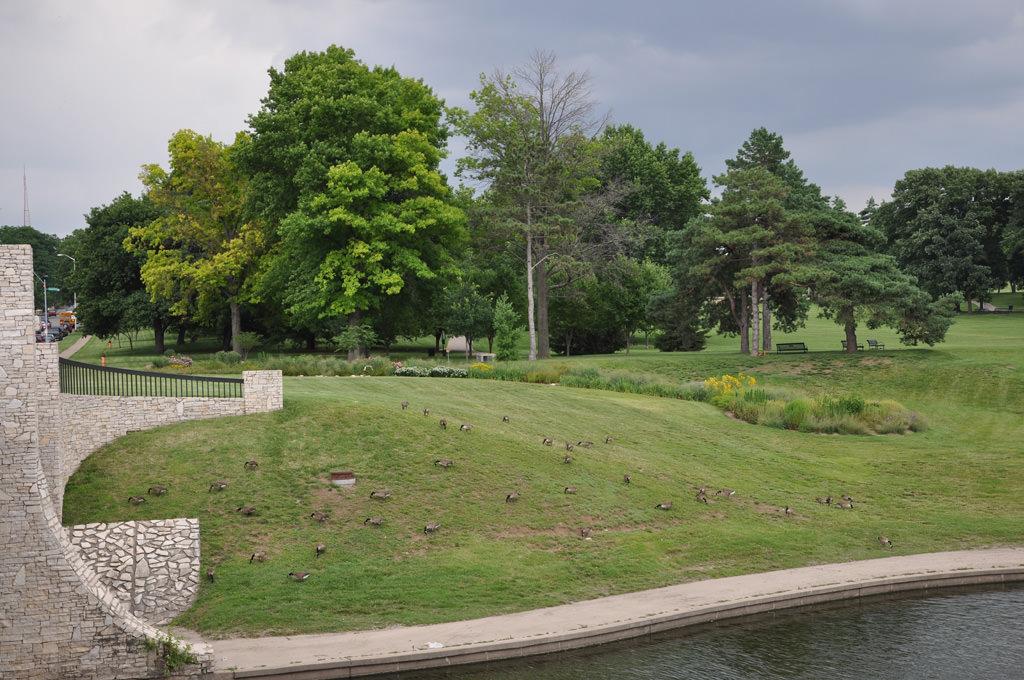
KCAI Brush Creek Community Rain Garden, Kansas City, MO :: 2006-present.
View from Volker Boulevard. This beautiful community rain garden stems from former Kansas City Mayor Kay Barnes’ 10,000 Rain Gardens Initiative. Initially conceived and designed with students in a Persuasive Ecology and Design class taught by Julia Cole and Tyler Galloway, it consists of a 150-foot-long bio-swale and two bowl-shaped gardens.
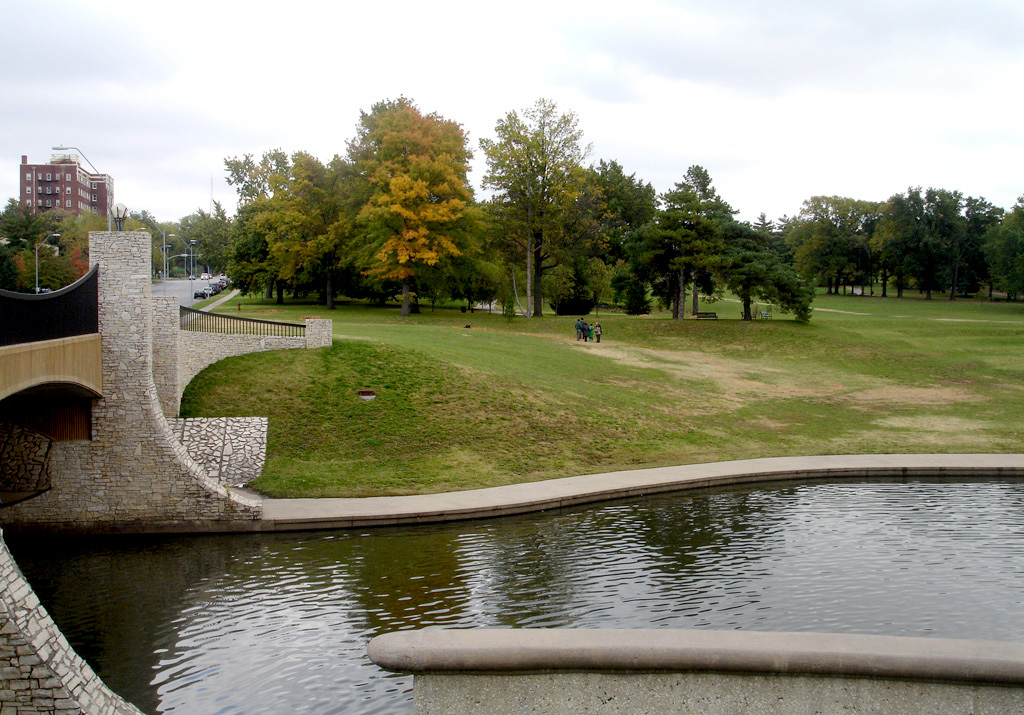
KCAI Brush Creek Community Rain Garden, Kansas City, MO :: 2006-present.
Site from Volker before the garden. The rain garden is located in a public park, on a slope above Brush Creek, in a spot that is highly visible to passing traffic. The creek has become an urban feature, with the potential to enhance the quality of life in the neighborhood.
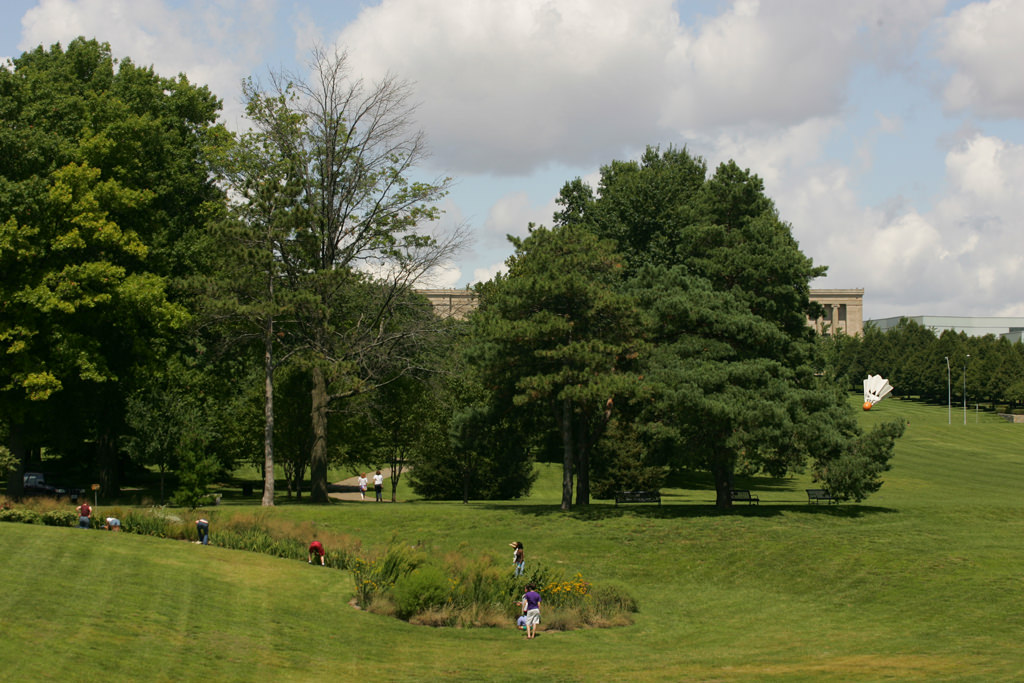
KCAI Brush Creek Community Rain Garden, Kansas City, MO :: 2006-present.
Garden with the Nelson in background. The land on which the garden is located is owned by the Kansas City Parks department, and is part of a mall that leads up to the stately Nelson-Atkins Art Museum. The building can be seen in the background, as can one of Claes Oldenburg’s Shuttlecocks.
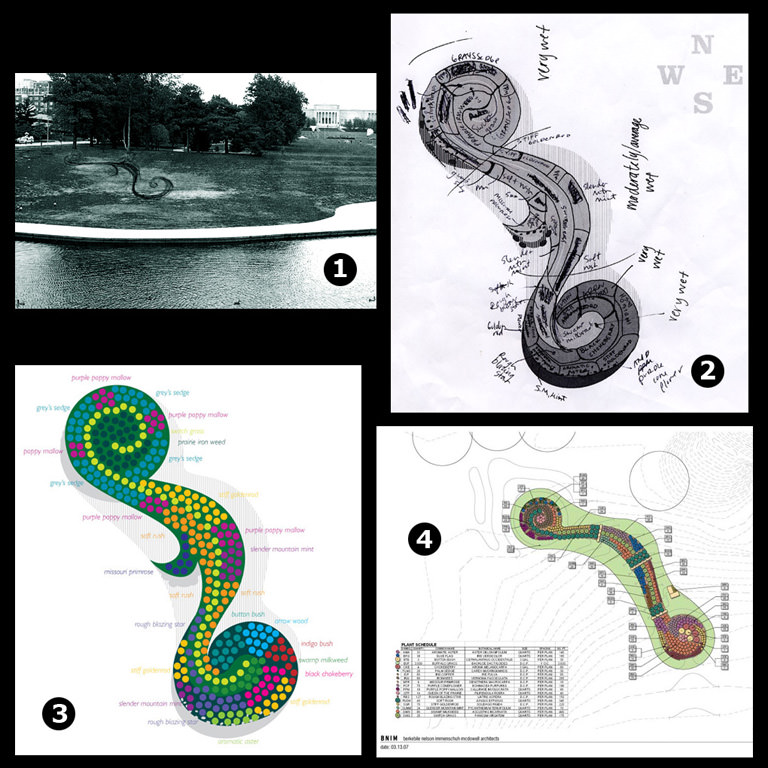
KCAI Brush Creek Community Rain Garden, Kansas City, MO :: 2006-present.
Sketches in development. The design for the garden was deliberately more formal than many wild-flower gardens, to show city residents that native plants could be used in their own gardens in beautiful ways that satisfy many local gardeners' desire for structure. This image shows a series of student sketches and then formal construction drawings made by BNIM architects, who were among the many local businesses that donated time and expertise to make the garden happen.
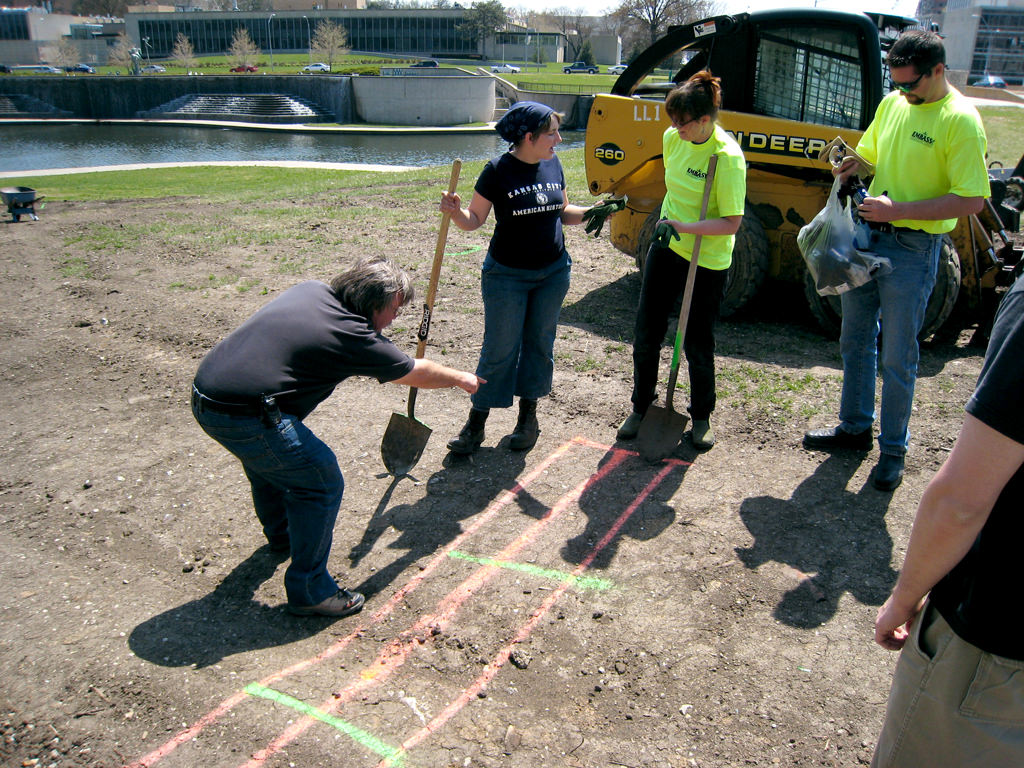
KCAI Brush Creek Community Rain Garden, Kansas City, MO :: 2006-present.
Laying out the garden and beginning digging for the first check dam. A Kansas City construction company contributed to the project by first excavating the compacted soil at the site, and a local green landscaping business donated time, labor, equipment and materials to help shape and plant the garden. The final layout was brought to life by a close collaboration between government agencies, local businesses, community stakeholders and area residents. It was the first large-scale public rain garden built in the city, and required a unique collaboration with the Parks system.
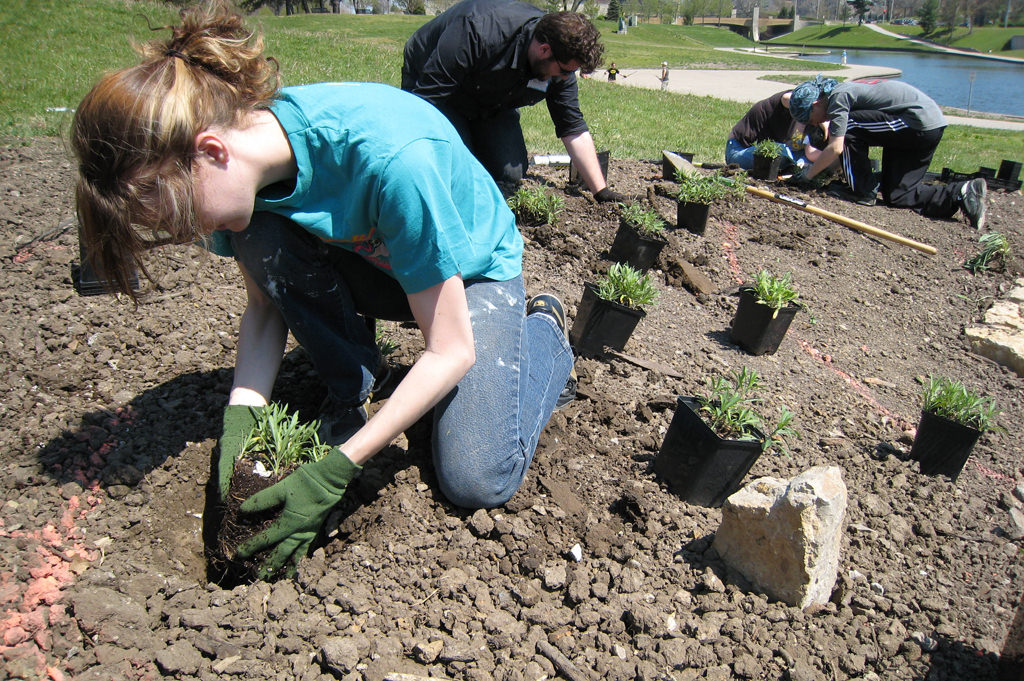
KCAI Brush Creek Community Rain Garden, Kansas City, MO :: 2006-present.
Planting day. Even though the garden could not be planted in the fall semester in which the class was taught, many of the students turned out the following May to help put the hundreds of donated native plants in the soil.
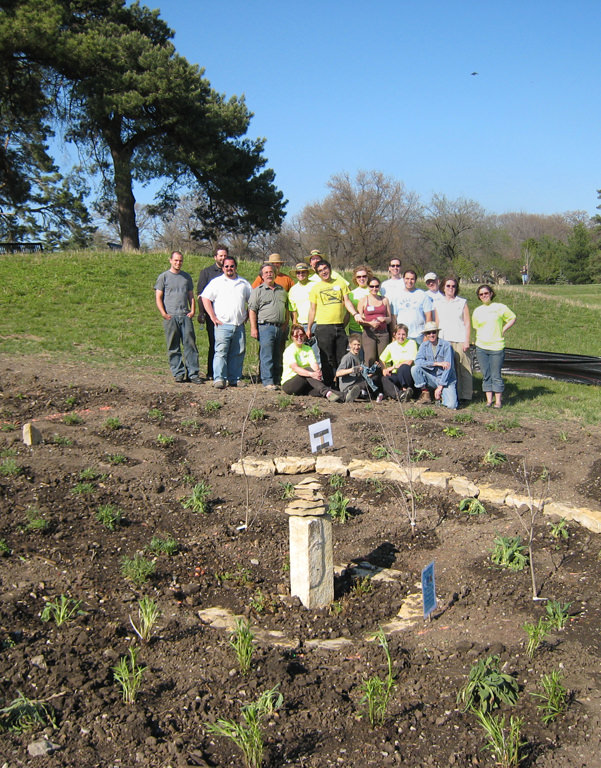
KCAI Brush Creek Community Rain Garden, Kansas City, MO :: 2006-present.
Group of volunteers who dug and planted the garden. The people in this image were the ones who remained at the end of a long day and were able to see the initial work completed.
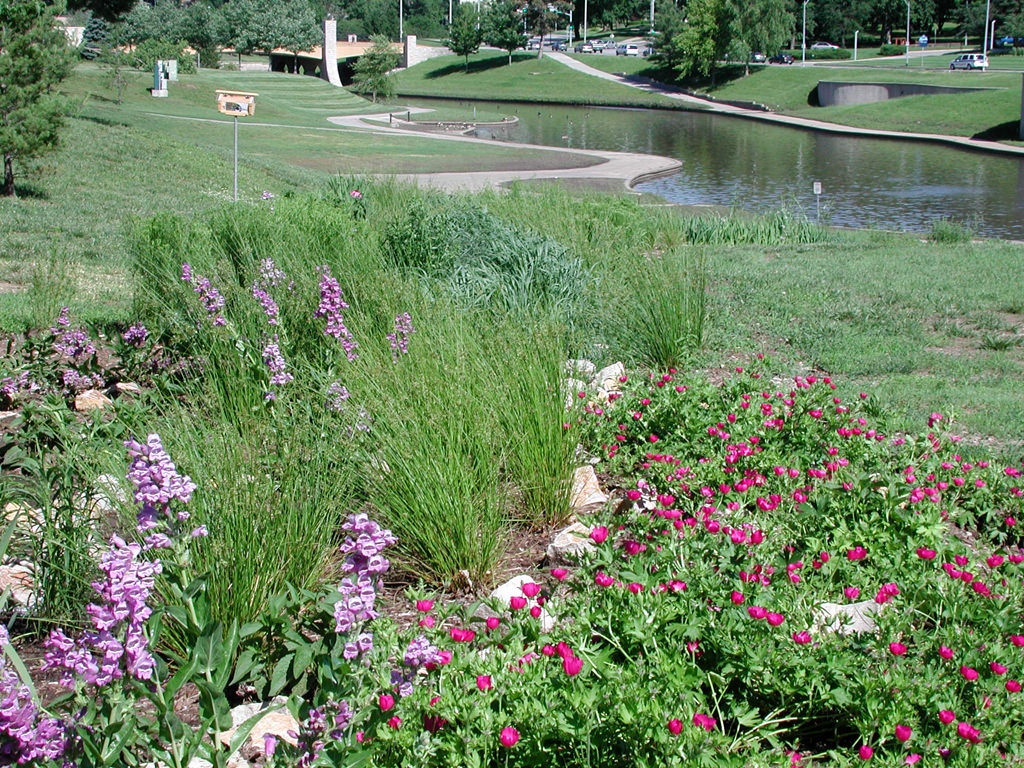
KCAI Brush Creek Community Rain Garden, Kansas City, MO :: 2006-present.
Grasses down the swale. Despite the promise of the creek as a recreational facility it had become an example of how poorly planned urban development can create many complex problems. The widespread replacement of native prairie with impermeable surfaces, run-off water containing particulate and bacterial pollution, and a combined sewage/storm drain infrastructure lead to flooding and waterway contamination during the torrential downpours that often occur in the Midwest.
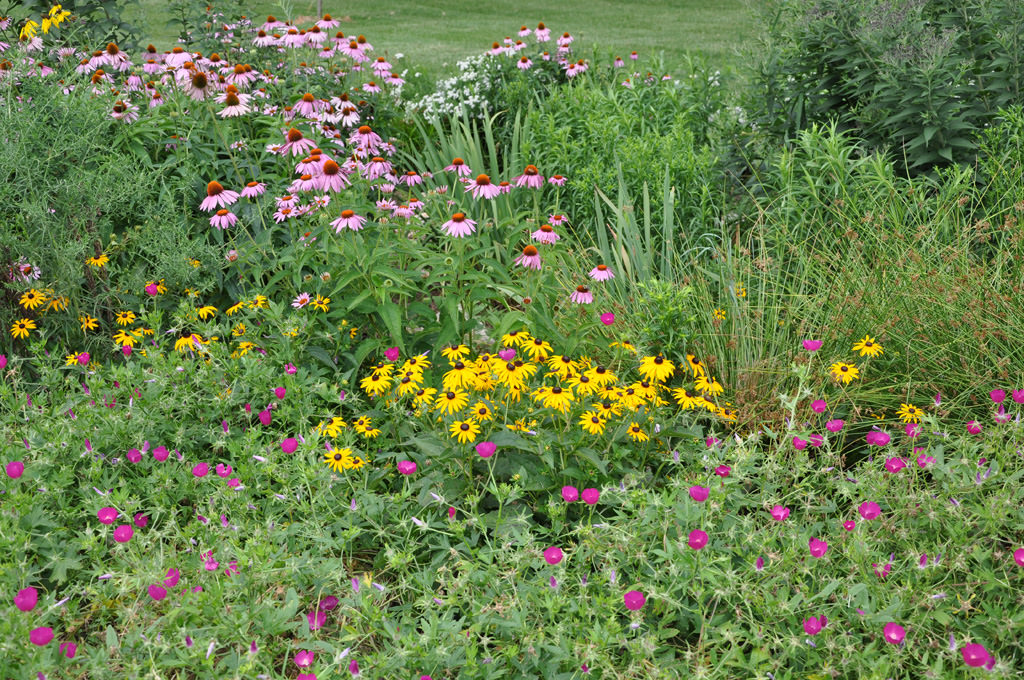
KCAI Brush Creek Community Rain Garden, Kansas City, MO :: 2006-present.
Top bowl in full bloom. When it rains in the neighborhood of the rain garden, water runs off from the surrounding turf and gathers in a rocky bowl planted with native grasses and wetland plants, known as a catchment bowl.
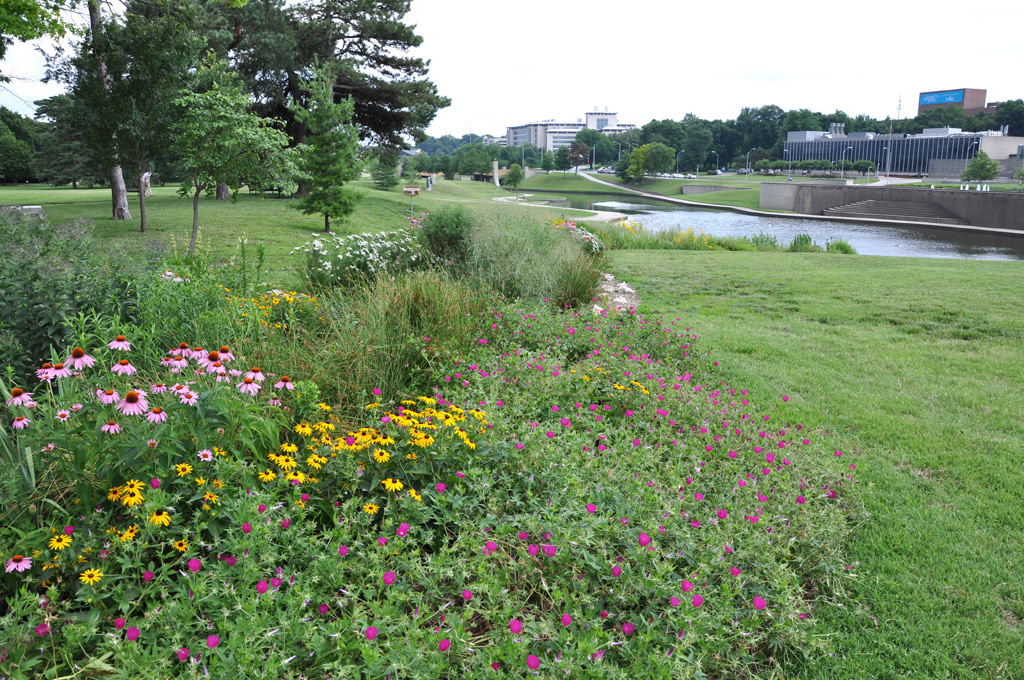
KCAI Brush Creek Community Rain Garden, Kansas City, MO :: 2006-present.
Looking down the swale full bloom The catchment bowl is located at the top of a swale, and water then flows downhill in a gently curving path toward a lower rain garden. The placement of rocks in the swale, the contouring of the slope and limestone check dams are all engineered to slow the water down as it flows downhill.
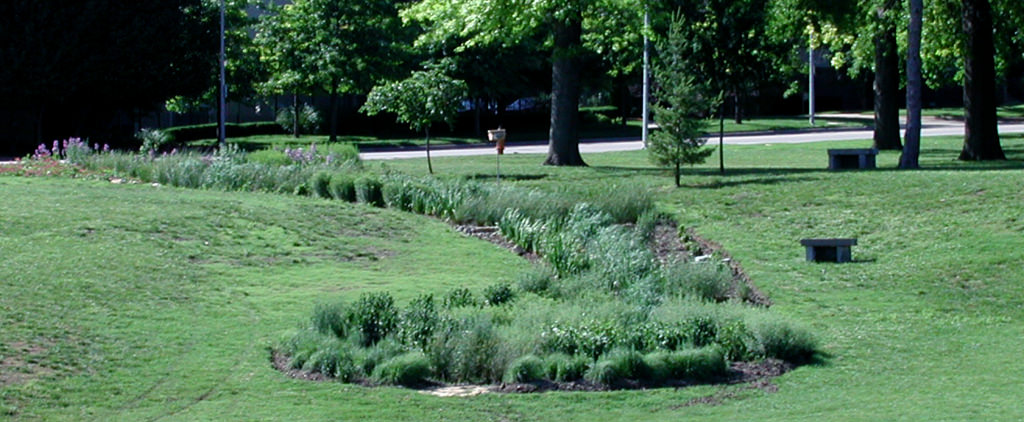
KCAI Brush Creek Community Rain Garden, Kansas City, MO :: 2006-present.
Lower bowl from Volker. Both bowls and the swale have been planted with Missouri native plants such as: button bush, slender mountain mint, purple poppy mallow, cone flowers, blue flag iris, purple beards tongue, rattlesnake master, switch grass, and other species chosen for their ability to withstand both wet and dry conditions in northwest Missouri.
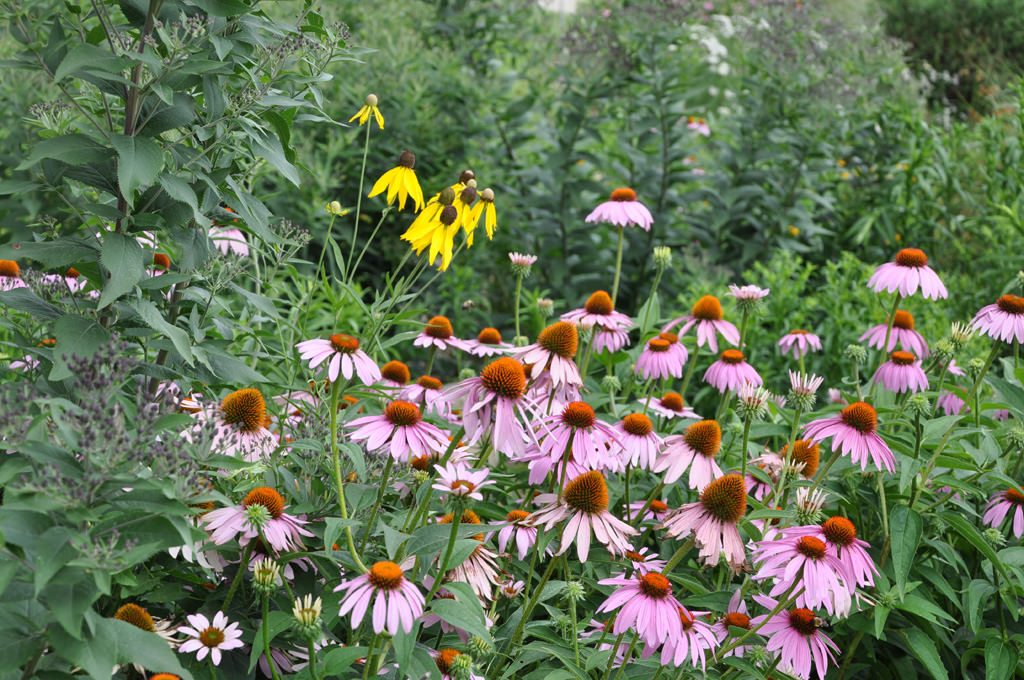
KCAI Brush Creek Community Rain Garden, Kansas City, MO :: 2006-present.
Close up showing Echinacea, Iron weed, and Grey Headed Coneflowers
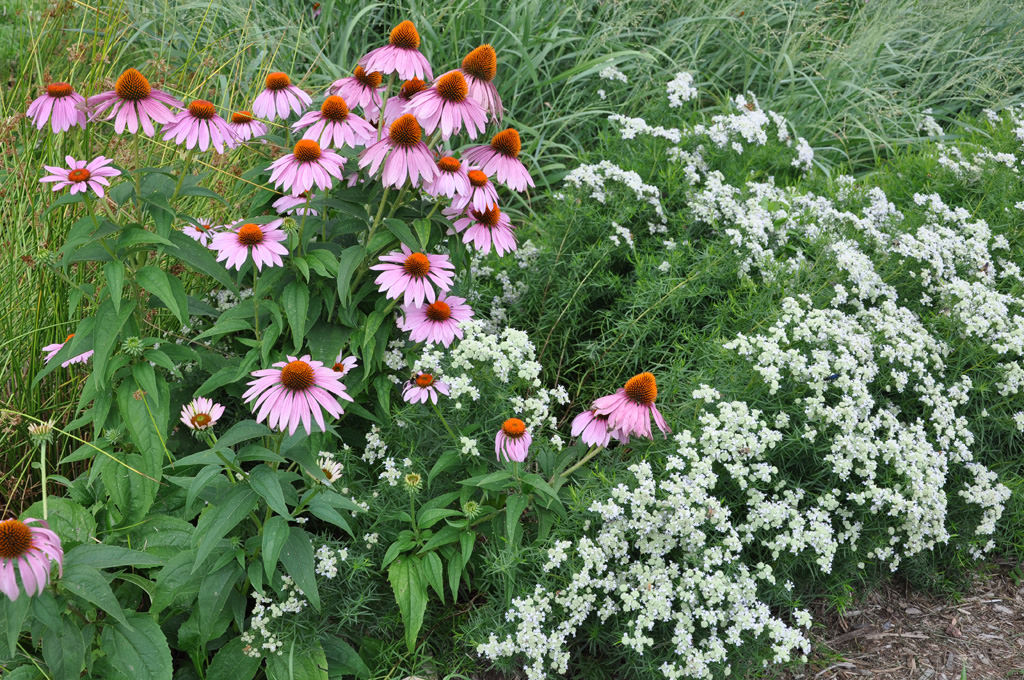
KCAI Brush Creek Community Rain Garden, Kansas City, MO :: 2006-present.
Close up showing Echinacea and Slender Mountain Mint

KCAI Brush Creek Community Rain Garden, Kansas City, MO :: 2006-present.
Top of garden from the side. The native plants will thrive because of their deep root system (10-25ft) that allows them to soak up and cleanse rain and floodwater.
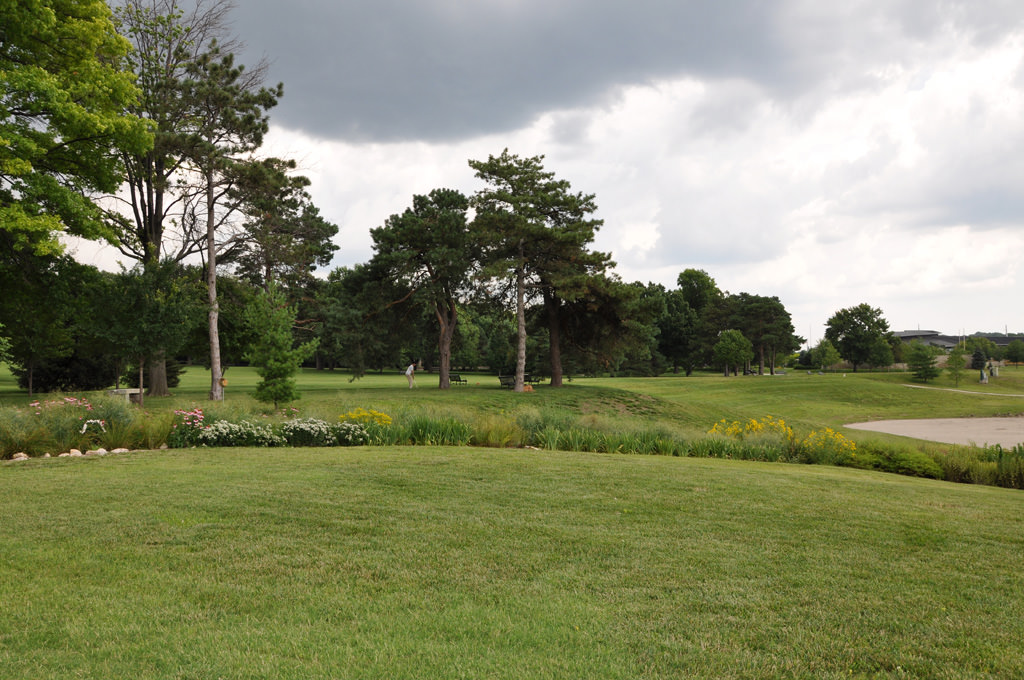
KCAI Brush Creek Community Rain Garden, Kansas City, MO :: 2006-present.
Mid garden from the side. Capturing rain where it falls alleviates the stress on the combined sewer system during periods of heavy rain.
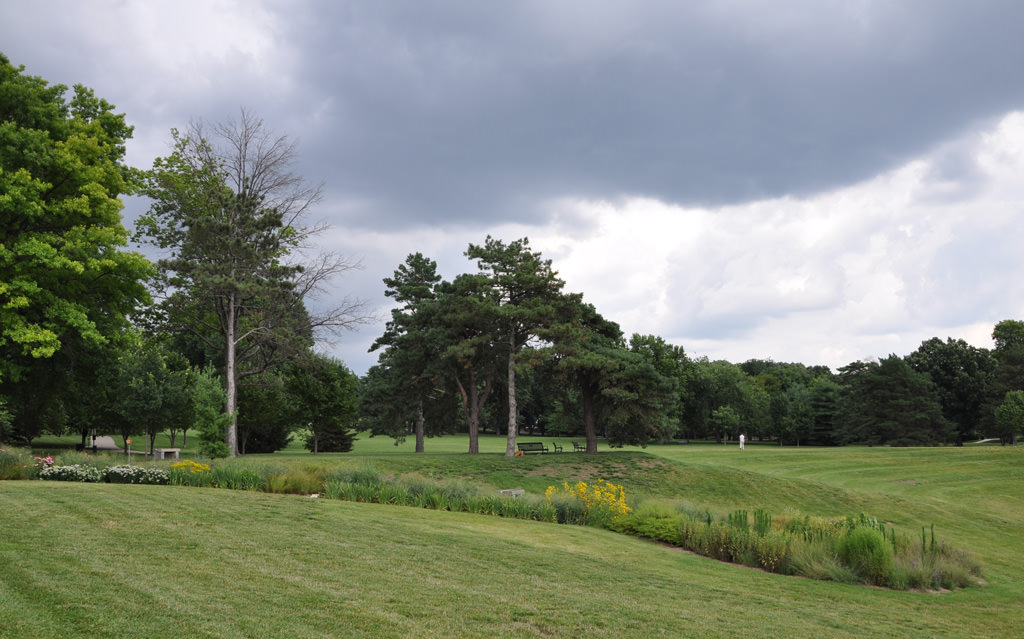
KCAI Brush Creek Community Rain Garden, Kansas City, MO :: 2006-present.
Lower garden from the side. Disrupting surface run-off prevents the overflow of warmed, polluted and untreated water into our creeks and rivers.
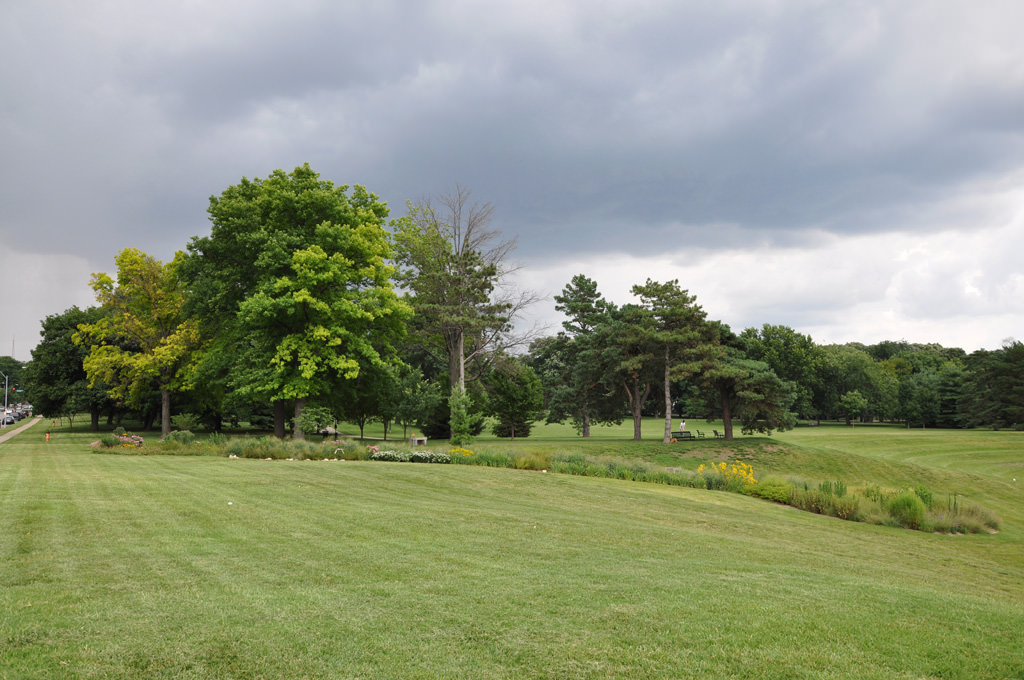
KCAI Brush Creek Community Rain Garden, Kansas City, MO :: 2006-present.
Whole garden from the side. An additional benefit of native plantings is that they provide a rich habitat for a diversity of insects, as well as small mammal and bird species.
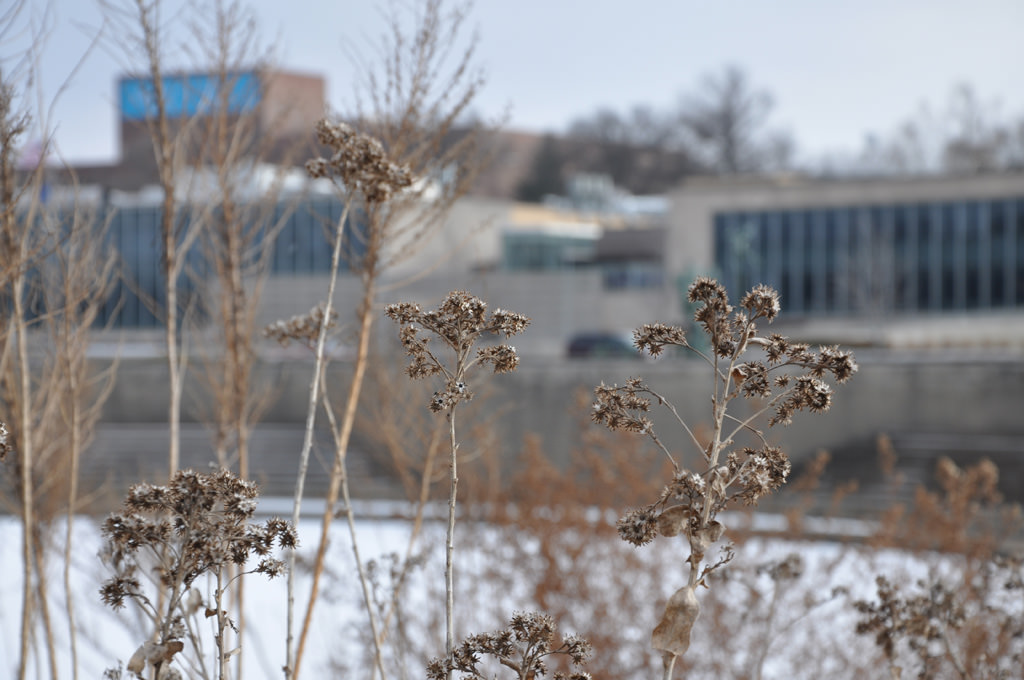
KCAI Brush Creek Community Rain Garden, Kansas City, MO :: 2006-present.
Seed heads in the winter, frozen creek in the background. Even in the middle of winter, there are still seeds on the native plants to sustain hungry creatures. Leaving the seed heads in place until the spring also adds visual interest in the winter months, and helps the garden produce seedlings to increase the density of native plants and out-compete invasive weeds.
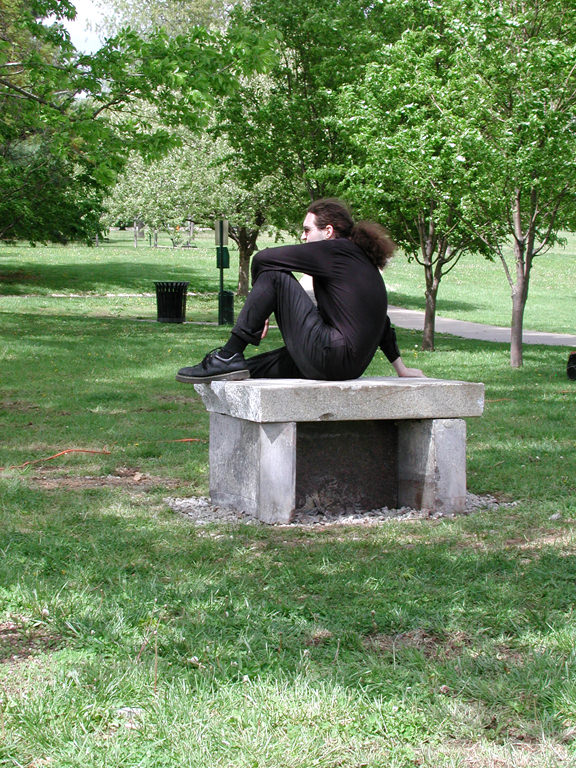
KCAI Brush Creek Community Rain Garden, Kansas City, MO :: 2006-present.
Granite bench. The granite for the garden benches comes from old city streets, and the limestone slabs in the check dams are from old buildings at the school where the class was taught.

KCAI Brush Creek Community Rain Garden, Kansas City, MO :: 2006-present.
Table with stones and seedballs. The garden was intended from the beginning to be an educational site to teach visitors about storm-water issues and the benefits of native plants. At a gathering held at the garden, guests were offered gifts to take home, including small clay stones with texts carved into them, and clay and compost balls that contain an assortment of native seeds.
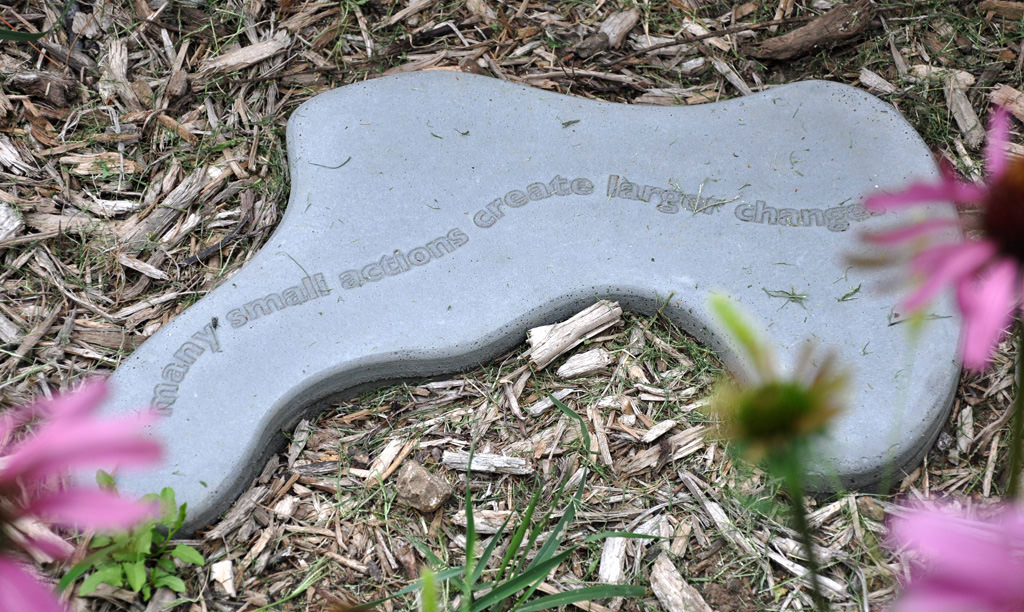
KCAI Brush Creek Community Rain Garden, Kansas City, MO :: 2006-present.
Close up text stone – many small actions create larger changes. Cast cement stones were designed and made by one of the students, and many participated in choosing the texts they would bear. They have been set into the ground throughout the rain garden, and explain the purpose and benefits of rain gardens from an ecological perspective, as well as the influence that urban life has had on the natural cycling of water throughout a community.
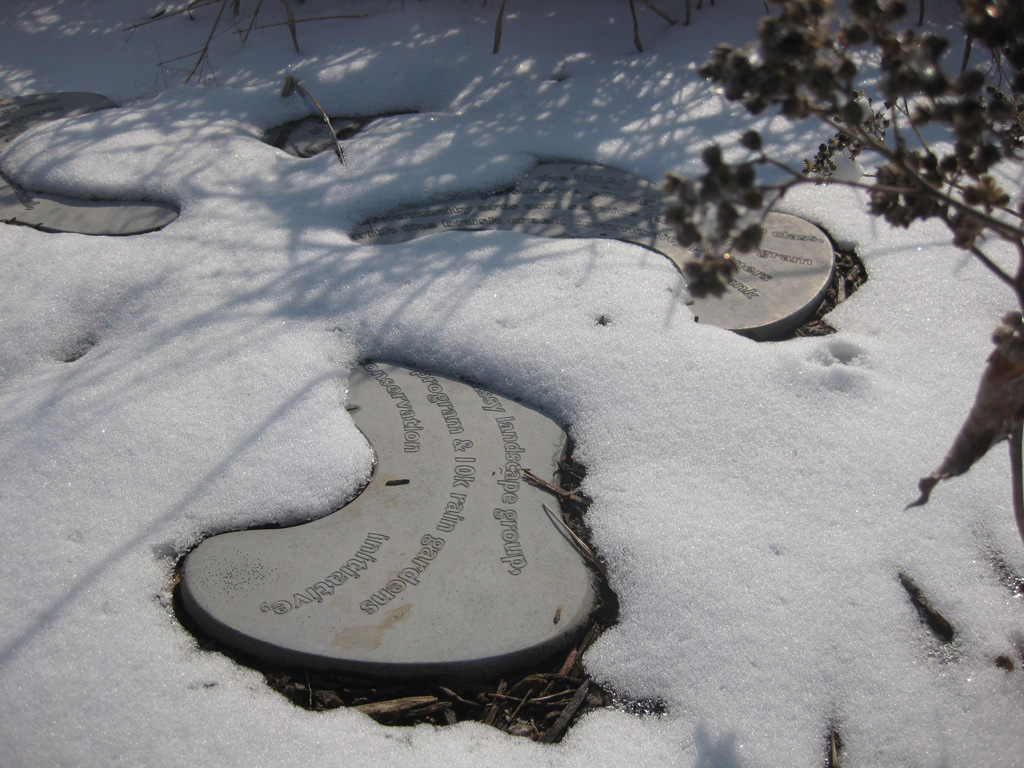
KCAI Brush Creek Community Rain Garden, Kansas City, MO :: 2006-present.
Text stones in the snow. These stones are also a means to thank all those who contributed to this community partnership, and this cluster acknowledges all the people and organizations who participated in some way.
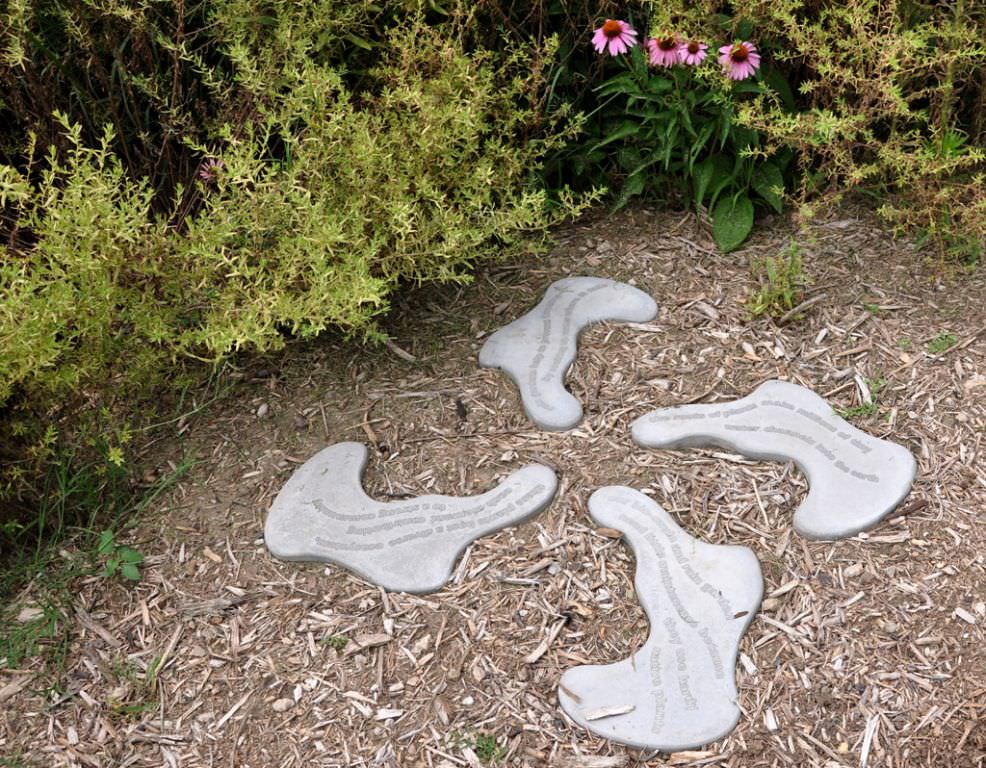
KCAI Brush Creek Community Rain Garden, Kansas City, MO :: 2006-present.
Four text stones about the garden. Over time the garden will fill in completely with seedlings, minimizing weeding and maintenance. At that point the text stones will have to be moved into the turf surrounding the garden.
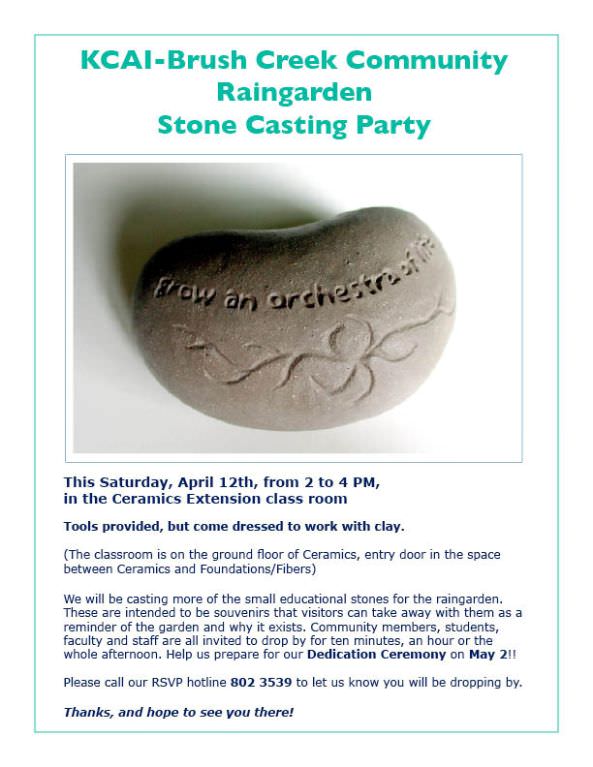
KCAI Brush Creek Community Raingarden :: 2006-present.
Stone casting party ad. Students and local community members also collaborate periodically to create small, natural-looking cast stones engraved with educational and poetic texts. The small “message stones” made from high-fired clay then become aesthetic and educational souvenirs for visitors to the garden, and gifts for volunteers who help to maintain the garden.
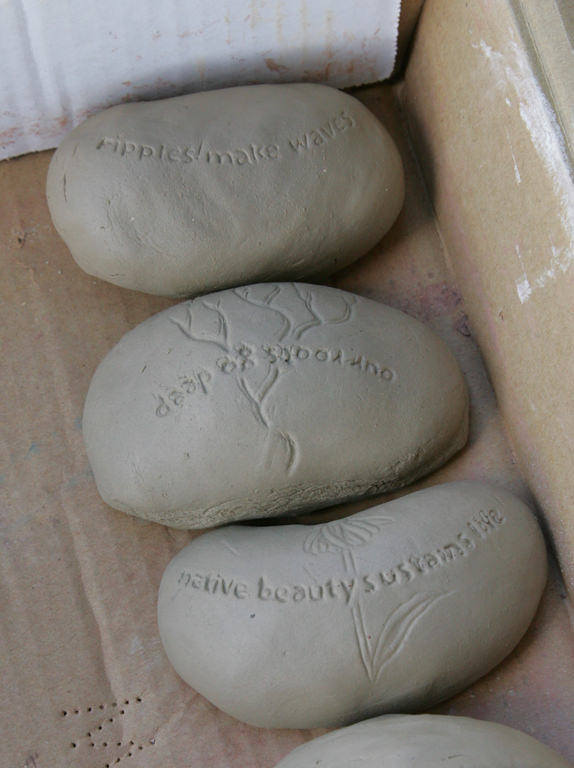
KCAI Brush Creek Community Rain Garden, Kansas City, MO :: 2006-present.
Making stones. The students who designed these hoped that such inspirational ideas and ecological understanding would motivate Kansas City residents towards a cleaner, more beautiful and sustainable future.

KCAI Brush Creek Community Rain Garden, Kansas City, MO :: 2006-present.
Julia teaching students about the garden. Each fall the garden becomes an opportunity to teach a new batch of incoming freshmen about the importance of sustainable practices.
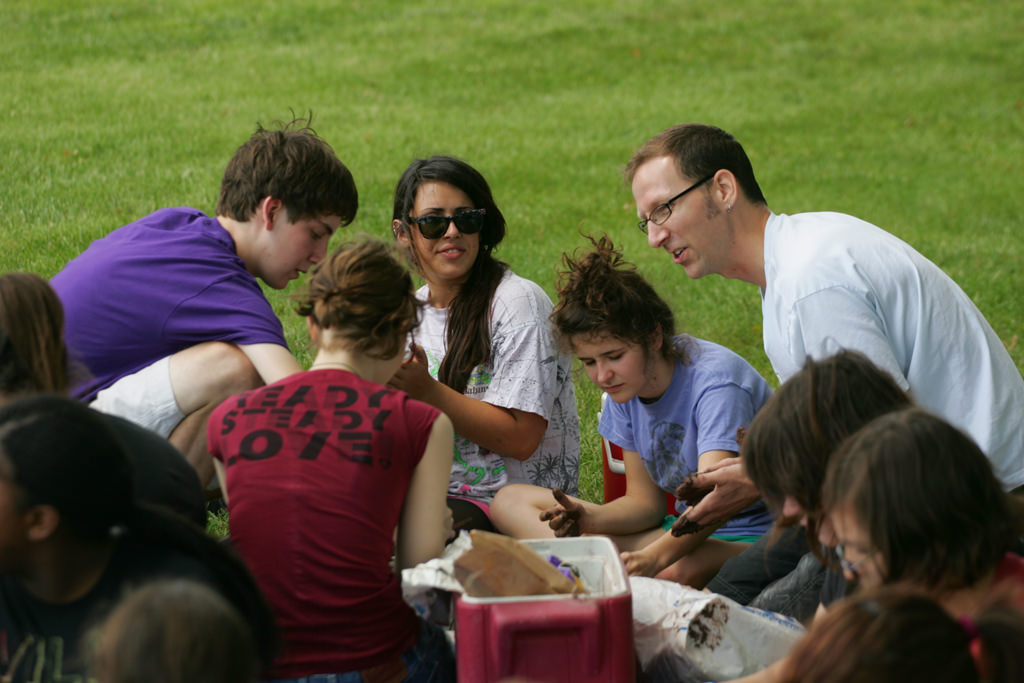
KCAI Brush Creek Community Rain Garden, Kansas City, MO :: 2006-present.
Here Tyler is working with students to create seedballs for future events.
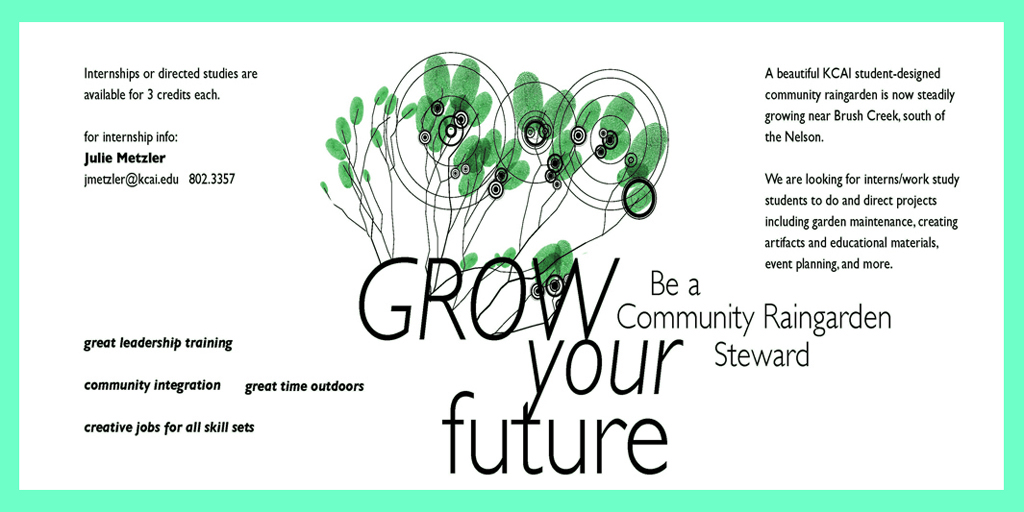
KCAI Brush Creek Community Rain Garden, Kansas City, MO :: 2006-present.
Intern ad. The garden is fulfilling its goal to be both a source of pleasure and a site for learning in the local community. Events and art installations are now scheduled there regularly, and a student internship provides an opportunity to learn about sustainable practices and community organizing.
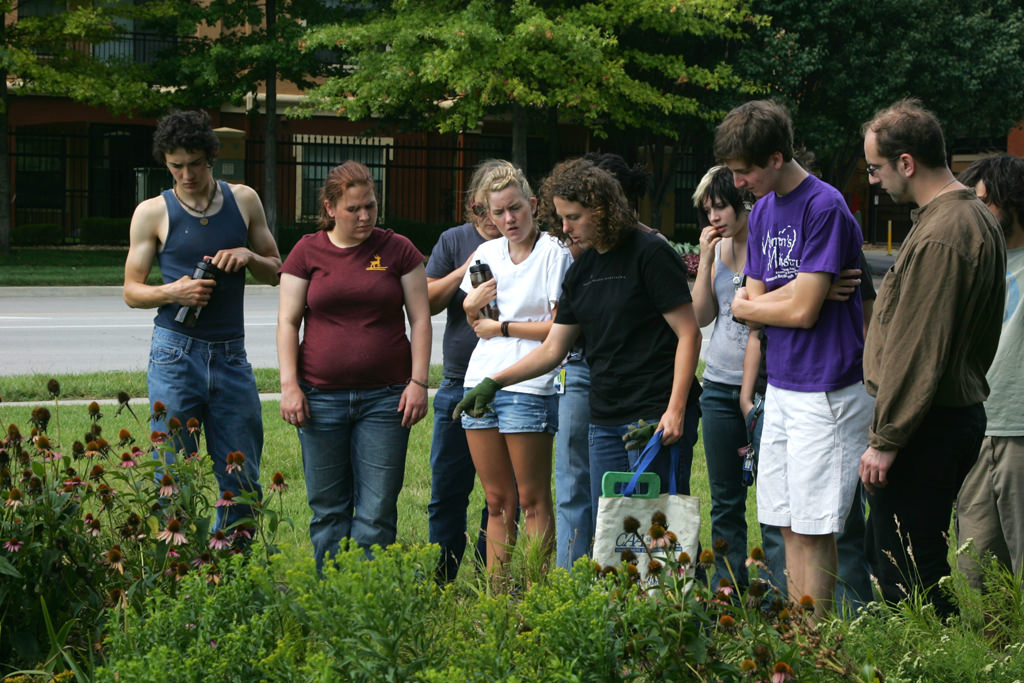
KCAI Brush Creek Community Rain Garden, Kansas City, MO :: 2006-present.
Intern teaching other students. Interns do everything from working in the garden, to teaching others about it, to organizing events, to communicating with partners and volunteers.
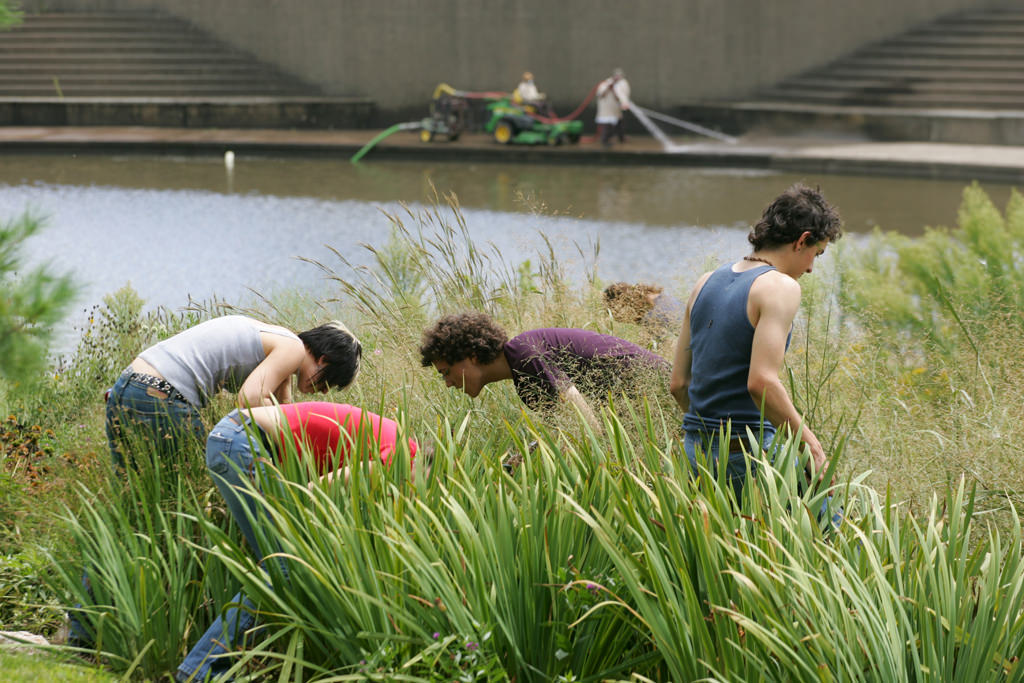
KCAI Brush Creek Community Rain Garden, Kansas City, MO :: 2006-present.
Students weeding with a clean up crew in the background. This image shows both the problem and its remediation, as young people come to understand how they can invent and implement creative solutions.
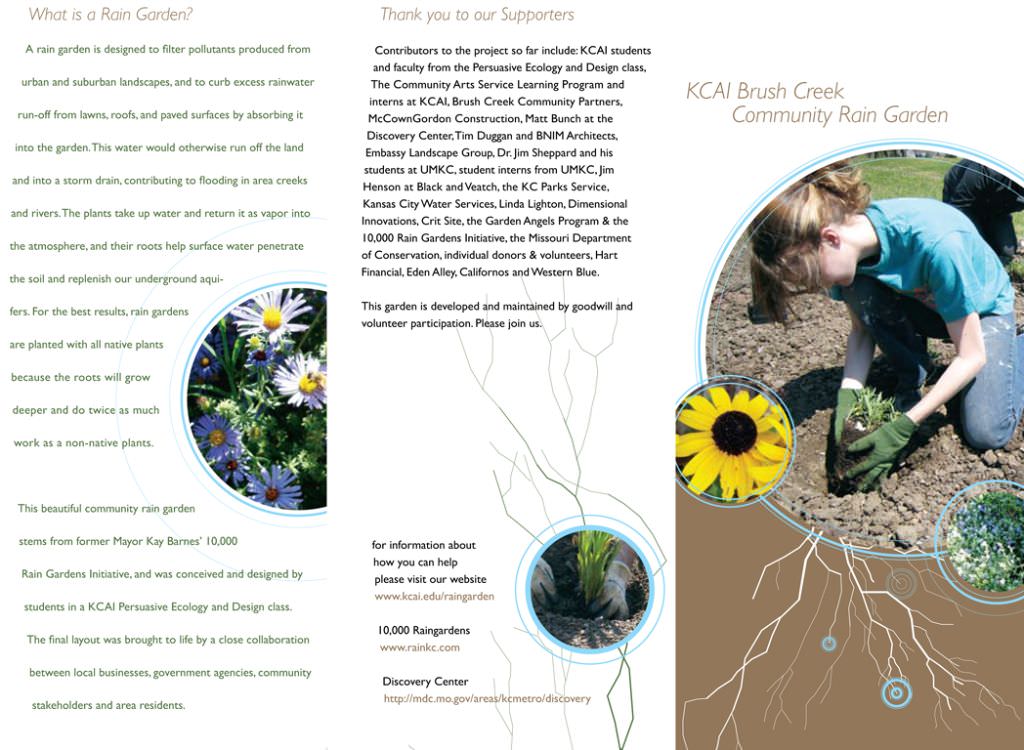
KCAI Brush Creek Community Rain Garden, Kansas City, MO :: 2006-present.
Brochure, outside. This project has thoughtfully developed persuasive materials for community outreach, all researched by Julia and designed by Tyler, with assistance from student design interns. This is a brochure that is used to inform people about the garden and how it was built.

KCAI Brush Creek Community Rain Garden, Kansas City, MO :: 2006-present.
Brochure, inside. This material focuses on the problems and solutions addressed by the garden.
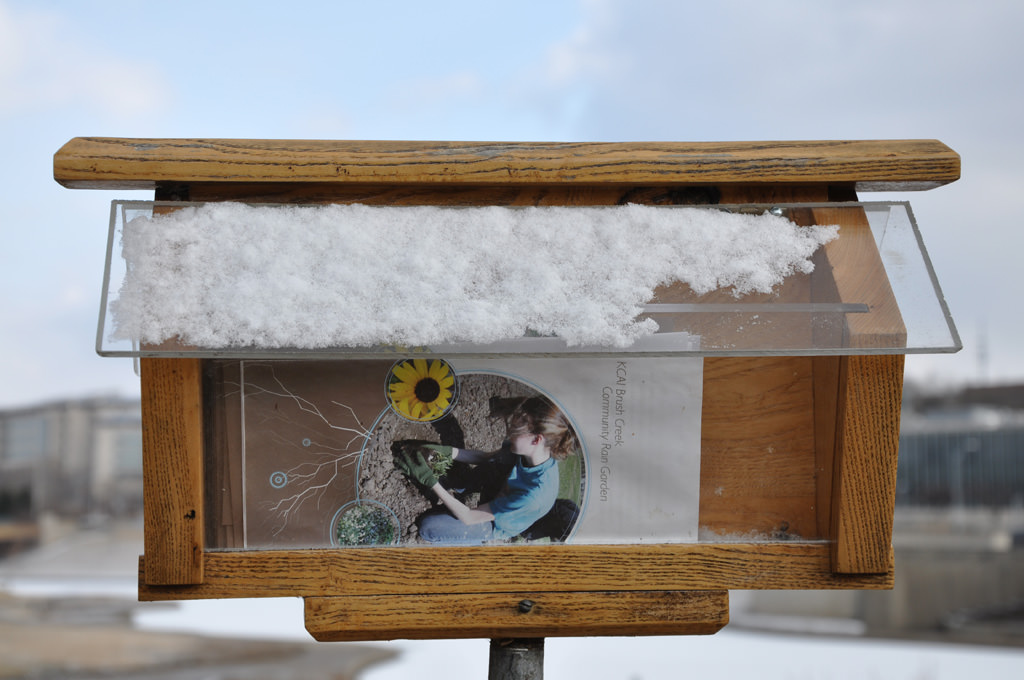
KCAI Brush Creek Community Rain Garden, Kansas City, MO :: 2006-present.
Brochures in their dispenser. A student built this container so that visitors to the garden could pick up a brochure if they were interested in finding out more about it. The brochure contains a link to a website where other materials can be accessed.
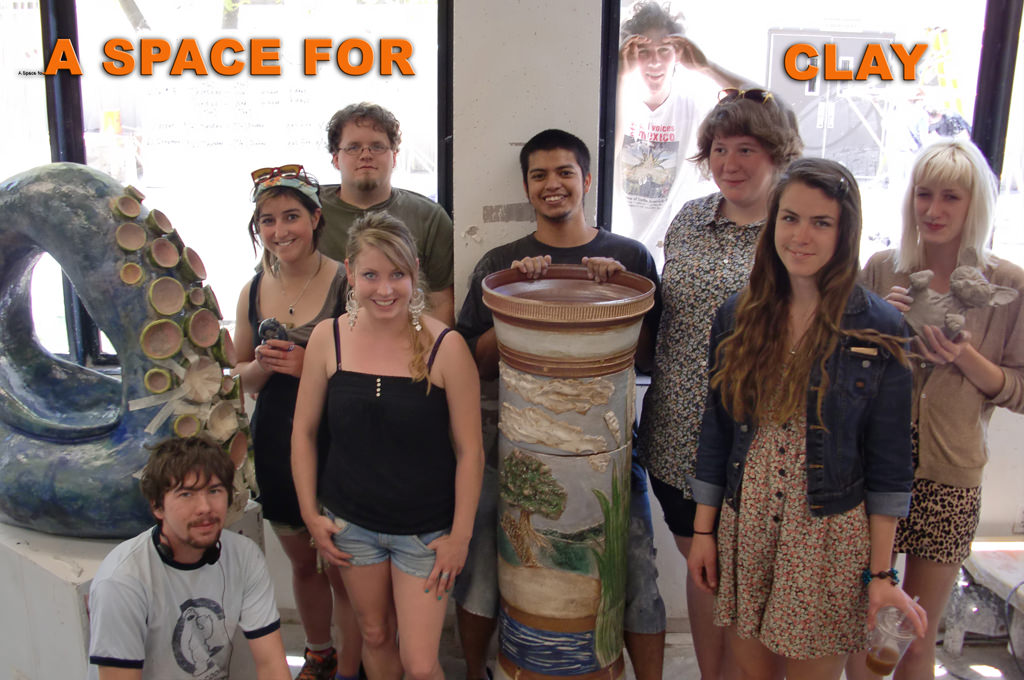
KCAI Brush Creek Community Rain Garden, Kansas City, MO :: 2006-present.
Students with ceramic art work to place in the garden. The garden has become a site for many different events, celebrations and engagements. In 2010 ceramic artist Misty Gamble taught a class called A Space For Clay that used the rain garden as an installation space. The work was all tailored specifically for the environmental, educational and public nature of the site.
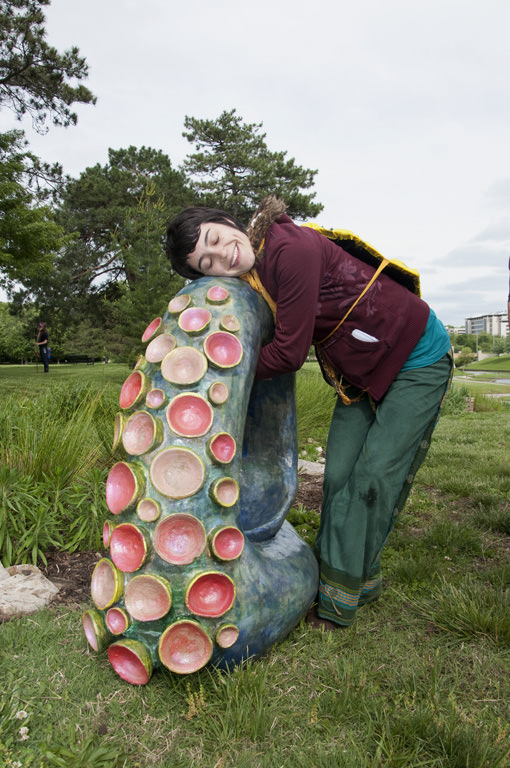
KCAI Brush Creek Community Rain Garden, Kansas City, MO :: 2006-present.
Student admiring some of the artwork installed in garden.
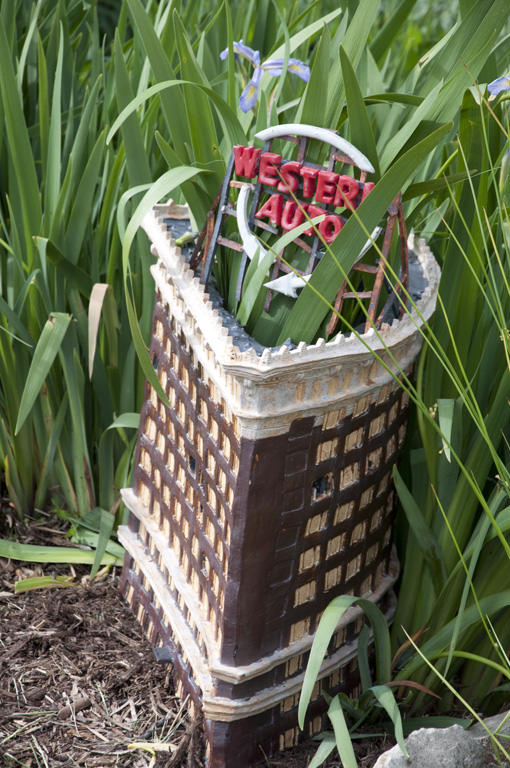
KCAI Brush Creek Community Rain Garden, Kansas City, MO :: 2006-present.
Sculpture in the garden. This is a model of a landmark building from downtown Kansas City, with its highly visible signage. The student wanted the vegetation to grow up through the edifice as if it were being reclaimed.
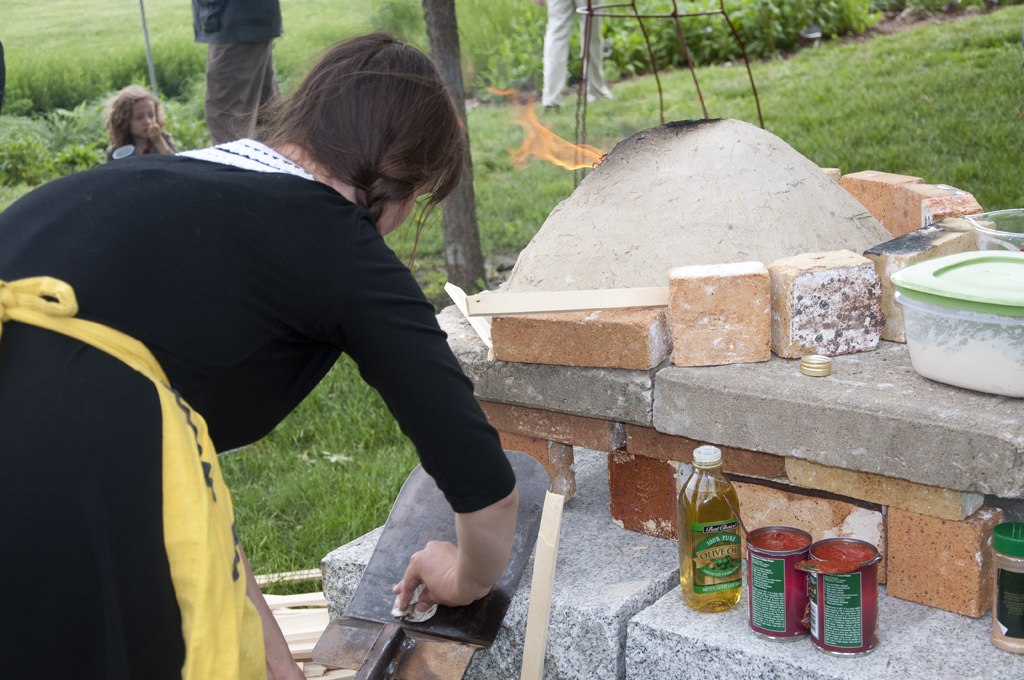
KCAI Brush Creek Community Rain Garden, Kansas City, MO :: 2006-present.
One of the students in the class made a pizza oven that was used to make food at the show opening.
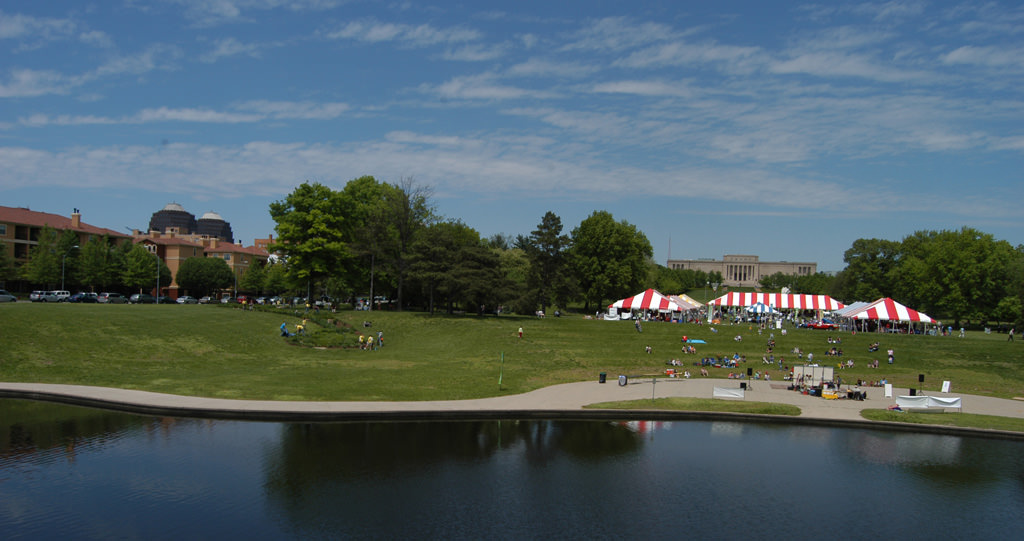
KCAI Brush Creek Community Rain Garden, Kansas City, MO :: 2006-present.
Earth Festival and garden from Volker. A real discovery for this project was that the relationships that grow over the course of a collaborative endeavor often lead to more powerfully productive partnerships. The garden now has a steering committee composed of some of the most active and innovative movers and shakers in the Kansas City environmental movement, and the planning for its long-term maintenance is becoming a model for community-based green initiatives across the region. This image shows an Earth Festival organized by Keep Kansas City Beautiful/Bridging the Gap, at which volunteers from a local business came to do a huge garden clean up. Missouri Master Gardeners also set up a booth to educate visitors about native plants.
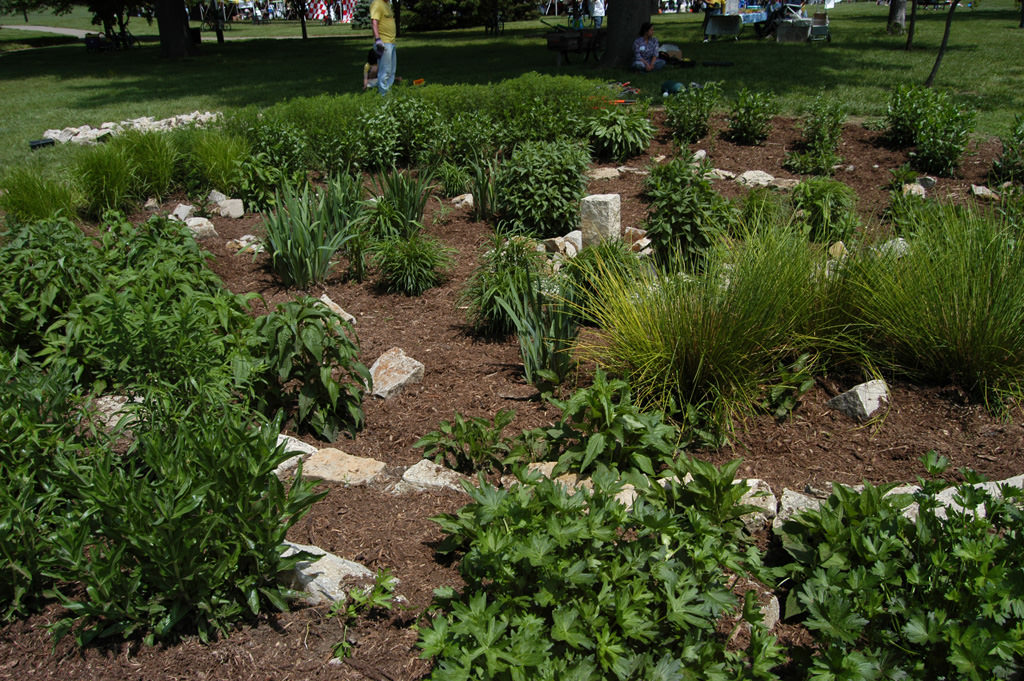
KCAI Brush Creek Community Rain Garden, Kansas City, MO :: 2006-present.
Upper bowl in the spring, after weeding and mulching by a 30 person volunteer crew. Such work parties are not only fun and educational, but work that would have taken one person several days to complete happens in just a couple of hours. Often, work parties find all kinds of surprises – toads, praying mantis egg cases, garter snakes, even a nest of baby rabbits. For many kids this has been their first close encounter with such creatures.
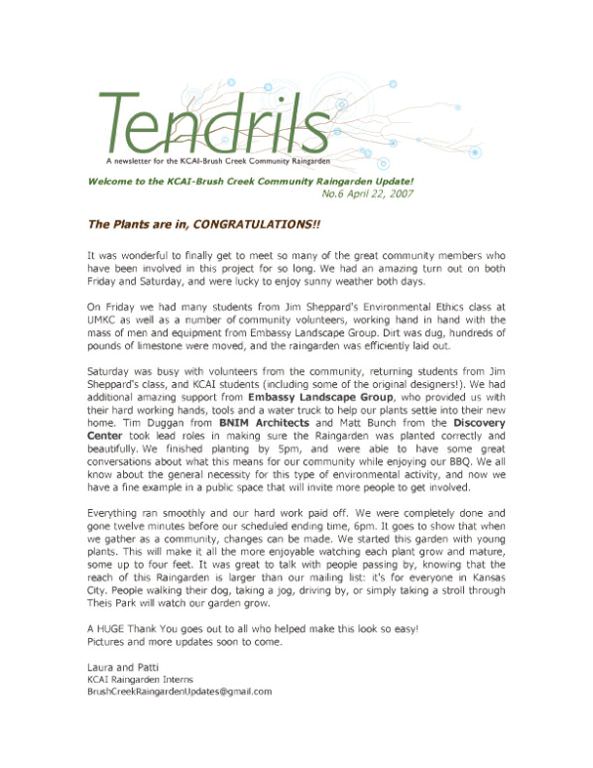
KCAI Brush Creek Community Rain Garden, Kansas City, MO :: 2006-present.
Tendrils issue number six. As part of the outreach to the community we developed this electronic magazine called Tendrils, featuring photos and stories from the rain garden, and news about upcoming events.
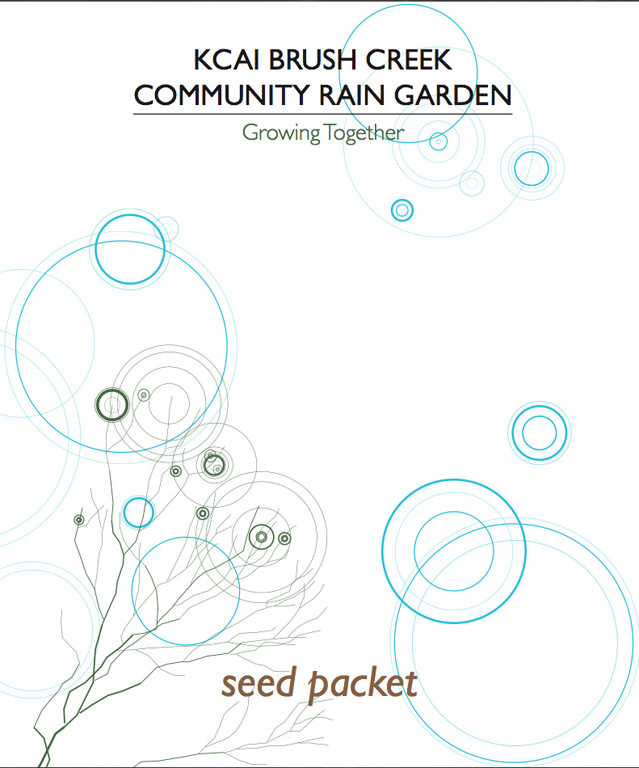
KCAI Brush Creek Community Rain Garden, Kansas City, MO :: 2006-present.
Seed Packet front cover. In order to both assist in the long-term maintenance of the garden, and to help others undertake a similar project, we developed an information packet that can be downloaded as a .pdf and printed out. It contains contact information for people, businesses and good resources, links to helpful websites, and information about routine maintenance tasks.
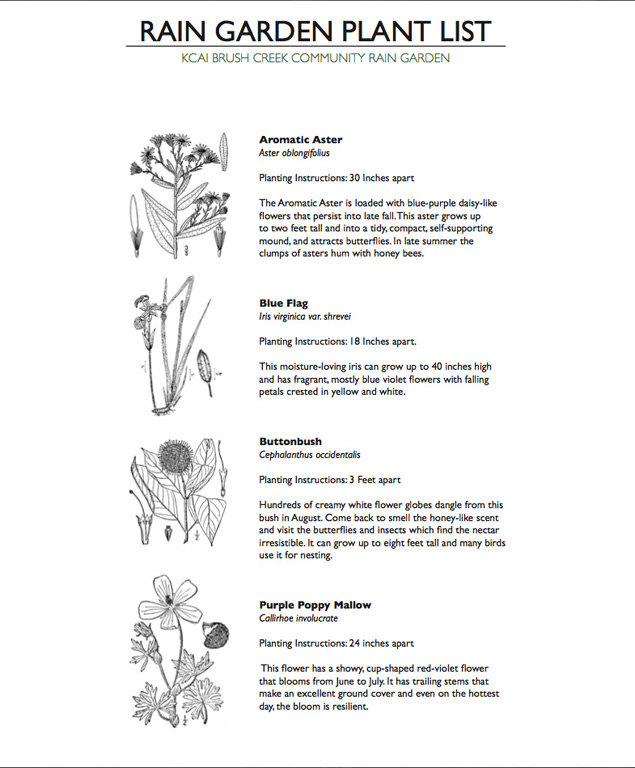
KCAI Brush Creek Community Rain Garden, Kansas City, MO :: 2006-present.
Seed packet plant list. It also has an illustrated guide to the native plants that are to be found in the garden, as well as the most common invasive weeds that should be swiftly removed to avoid imbalance as the garden develops.
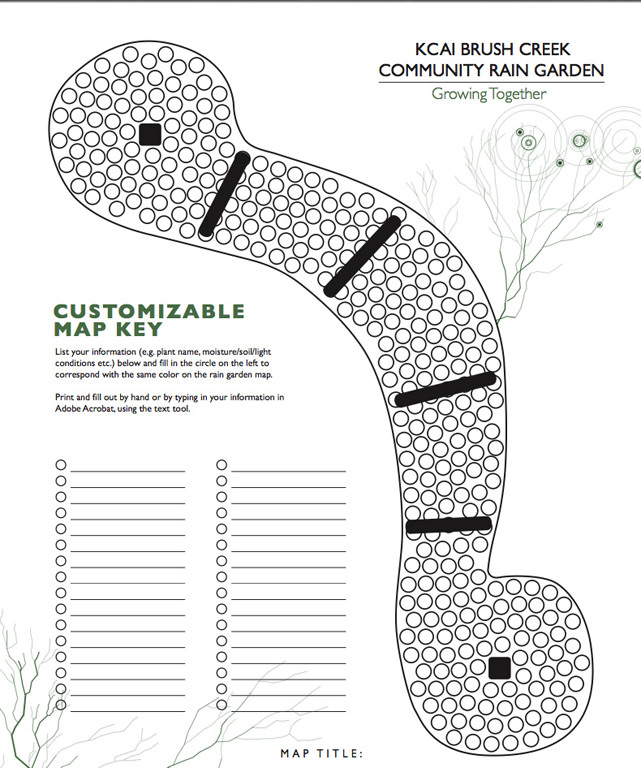
KCAI Brush Creek Community Rain Garden, Kansas City, MO :: 2006-present.
Seed packet map of the garden. This customizable diagram of the garden was intended to help future stewards and volunteers plan changes and interventions as the garden adapts to a changing climate and diverse community needs.


